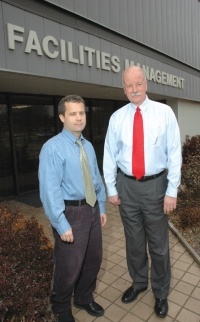UA Keeps up Expansion, Improvement Plans in ’09
by January 26, 2009 12:00 am 83 views

The University of Arkansas has over $75 million in construction projects set to begin in 2009.
One project is a 1,500-space parking garage on Garland Avenue. The $40 million project also includes a 30,000-SF university bookstore and 20,000 SF of retail space.
Mike Johnson, associate vice chancellor for facilities, said the garage is expected to be complete by July 2010.
Construction is scheduled to begin in January on a new home for the University’s public radio station, KUAF-FM, 91.3.
A university property on S. School Street, across from the Fayetteville Public Library, will be renovated and expanded for a total of 15,000 SF. That project is expected to cost about $1.5 million and be complete by January 2010.
University officials are hoping to break ground in June on a Nanotech facility between the Kappa Sigma Fraternity house and the Dickson Annex on Dickson Street. The building’s design includes about 7,400 SF of specialized research space. Johnson said the building is expected to cost between $28 million and $56 million, depending on how much of its gets built out.
Another project will enhance fire safety measures in the fine arts building as well as expand the space to make room for a scene shop.
Renovations will also be made to Davis Hall on the corner of Garland Avenue and Maple Street, which previously served as the law programs building.
The current plan, Johnson said, is for the University Relations department to take over that space once its renovated.
In addition to construction projects, the University is planning to invest several million dollars in an energy savings plan.
In April, work will begin on the heating plant. Johnson said the University will invest $14 million in improvements to the plant for a 15-year payback in energy savings. Improvements will also be made to 56 buildings on campus for an investment of $23 million with a 13-year payback.
About $40 million will be invested over a three-year period, Johnson said, with a payback of 11 to 15 years.
The project will be funded with bonds and capital lease money, he said, and the debt service will be paid with the savings in the energy bills.
“Essentially, we’re self-financing the project,” Johnson said.
The improvements will focus on more efficient lighting and water conservation. Buildings will be equipped with occupancy sensors so lights and air control are turned off when there is no activity in a room. Bathrooms will be equipped with low-flow toilets and sensors on water faucets.
In 2008, $85 million was spent on campus projects, mainly on additions to university housing.
Phase II of the Maple Hill housing project and the Duncan Avenue Apartments added more than 500 student beds to the campus.
The third Maple Hill building, a $33 million project, added 350 beds to the existing 715 beds in the two buildings that were completed in 2007.
The Duncan Avenue Apartments, a $16.3 million project, added 50, four-bedroom apartments, for a total of 200 beds, to the campus’ housing numbers.
In December, construction was completed on the $5.8 million Alpha Omicron Phi sorority house on Maple Street, the first new sorority on campus in 17 years.
Athletic projects in 2008 included an $8.6 million women’s softball complex and $2.5 million in seat upgrades to the Bud Walton Arena.
In 2007, the University spent over $150 million on construction projects, including the $50.4 million Phase I of the Maple Hill Project and the $5.5 million Sigma Nu fraternity house.
Renovations to Walker Hall cost $22.4 million and $31.7 was spent on the J.B. Hunt building.
According to Jay Huneycutt, director of planning and capital programming for the facilities management department, contractors are selected for projects using two different methods.
For projects under $5 million, the University recommends the low bidder to the University’s Board of Trustees, which has the final say in the selection.
For negotiated projects, or projects over $5 million, Huneycutt said the University selects contractors based on their experience in campus projects. They are selected based on whether or not they meet the criteria for a specific project, he said.
